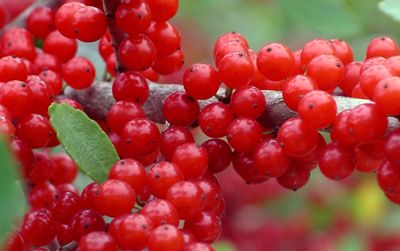December, 2017
Red Berries
by Valerie
Christmas is coming and red is bustin' out all over! Yes, I know I've just combined the lyrics from two completely different songs, but there's nothing more catchy than famous phrases with happy melodies. It is also no accident that these two tunes reference opposite seasons. While opposites might, or might not, attract, they also hold a special fascination for us. So why is red so ubiquitous for this time of year? It's easy to understand the symbolism related to the religious holiday, but the icons and their meanings must have originated long before our species marked the date just a bit over 2,000 years ago. From the time hominids left the climactically stable, warm heart of Africa and had to deal with marked annual seasons in the more extreme latitudes, I'd place a big bet that winter was NOT their favorite time of year. Finding food, keeping warm (remember, we don't have fur now and didn't back then either), and trying not to get too bored during long, dark nights, were probably less than enjoyable to our ancient ancestors. So, with the creativity made possible by our big brains, we figured out ways to feel better during dismal times, and a bright color like red was probably a real asset to the cause.
 Humans, unlike many mammals, have good color vision, which lets us find ripe fruit as well as pleasure in multihued juxtapositions. During the growing season, red jumps out at our eyes in the midst of green, which is abundant for obvious reasons. As leaves wither and photosynthesis declines in the autumn, those same brightly hued berries become even more pronounced against the resulting bland background of browns. Then comes the white snow, turning our previously vibrant world into a monotone landscape.
Humans, unlike many mammals, have good color vision, which lets us find ripe fruit as well as pleasure in multihued juxtapositions. During the growing season, red jumps out at our eyes in the midst of green, which is abundant for obvious reasons. As leaves wither and photosynthesis declines in the autumn, those same brightly hued berries become even more pronounced against the resulting bland background of browns. Then comes the white snow, turning our previously vibrant world into a monotone landscape.
It's little wonder that bright red and green have come to symbolize that darkest and coldest time: the winter solstice. And red berries that persist into the season are an easy way to get our color fix. Everybody knows that holly berries are red. Another popular plant at this time is mistletoe. It also has berries, but they are not nearly as often noticed, being a sort of creamy white tint. One other aspect to this contemplation is that red does not necessarily equal edible. Cranberries and raspberries are delicious treats, but, while birds can eat holly berries, they are poisonous to us mammals. Maybe the added danger factor of some red berries being toxic is yet another reason we find them enticing.
That some, and in fact many, red berries are delectable to birds but noxious to humans and other mammals is no surprise. The purpose of the fruit is to reward an animal for helping with the dispersal of seeds, which are the next generation of any flower, tree or shrub. The teeth of mammals can crush and kill even very well-packaged seeds, which is no help to a plant's reproductive goals. Birds, on the other hand, not only lack teeth, but they use airborne efficiency when it comes to dropping those intact baby plants into new habitats. With both pollination and seed distribution, plants have evolved elegant ways to utilize their animal neighbors for tasks that are difficult to perform if one is rooted in one place.
No matter what the practical mechanisms involved, the end result of all this is that we have a surfeit of red berries to tantalize our palate, enchant our eye, and brighten our world.
 Humans, unlike many mammals, have good color vision, which lets us find ripe fruit as well as pleasure in multihued juxtapositions. During the growing season, red jumps out at our eyes in the midst of green, which is abundant for obvious reasons. As leaves wither and photosynthesis declines in the autumn, those same brightly hued berries become even more pronounced against the resulting bland background of browns. Then comes the white snow, turning our previously vibrant world into a monotone landscape.
Humans, unlike many mammals, have good color vision, which lets us find ripe fruit as well as pleasure in multihued juxtapositions. During the growing season, red jumps out at our eyes in the midst of green, which is abundant for obvious reasons. As leaves wither and photosynthesis declines in the autumn, those same brightly hued berries become even more pronounced against the resulting bland background of browns. Then comes the white snow, turning our previously vibrant world into a monotone landscape.